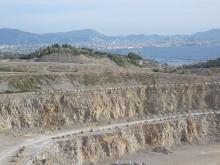
The European Landscape Convention celebrates its 10th anniversary next year and Robert Camp looks at its origins and how it impacts on Europe's aggregates industry
The European Landscape Convention (ELC) was the first international Convention to focus specifically on landscape and was adopted in October 2000. It was created by the Council of Europe to encourage public authorities to adopt policies and measures at all levels for protecting, managing and planning landscapes throughout Europe.
Because the convention is a treaty rather than a directive it has been flexibly drafted to allow signatory states to interpret its implementation. Nonetheless, its overall aim is to ensure a consistent approach to landscape issues across all 47 Council of Europe members, and it is binding on the 30 states that have so far ratified the treaty.
As with all international agreements it is no surprise that it has taken some time for the treaty to become transposed into national, regional and local regulations.
The Convention requires member states to frame and implement policies by systematically accommodating its aims into the country's spatial and town planning policies, as well as its cultural, environmental, agricultural, social and economic policies. It is for each member state to develop and introduce a range of instruments that is appropriate to the needs of its landscapes and its legal system.
That process was given added impetus last year when the Council of Europe approved detailed guidelines for the implementation of the ELC, noting that "developments in agriculture, forestry, industrial and mineral production techniques are in many cases accelerating the transformation of landscapes".
So what does it means for the aggregates industry? A great deal is the broad answer.
The convention introduced the concept of 'landscape quality objectives' to the protection, management and planning of geographical areas, and puts great emphasis on the identification and assessment of landscapes.
Once this identification work has been completed and the landscape quality objectives set, the landscape can be protected, managed or developed in line with those objectives. The industry's concern is that the overriding landscape quality objective is likely to be to protect, maintain and enhance the quality of quarries in a designated area to ensure the protection of geological features associated with them.
Further potential quality objectives may be to resist the loss of key geological features through quarrying and to increase understanding of the geological features.
Looking at each area in more detail, the convention defines 'landscape protection' as measures to preserve the character and quality of a valued landscape as a result of its distinctive natural or cultural configuration.
The types of quarries that will require the highest level of protection are those that are regionally important geological sites (RIGS). Member state's enforcement bodies will actively seek to identify and designate unrecognised important quarries as RIGS.
'Landscape management' is aimed at influencing and managing changes brought about by economic, social or environmental necessity. This area is likely to affect the industry most as a key problem is that active quarrying continually creates new exposures of geological interest, but can also destroy existing exposures, replacing them with features of lower interest.
Member state enforcement bodies will seek to implement a rolling programme of condition monitoring for RIGS.
'Landscape planning' involves the process of reshaping areas most affected by change, including protection and after-care of important geological features. This is likely to be achieved through planning permission conditions which will ensure the appropriate working and restoration of pits, quarries and cuttings.
In seeking the right balance between protection, management and planning of a landscape, the convention's aim is not to freeze the feature at a particular point. Instead it wants to manage future change in a way which recognises the diversity and the quality of the landscape.
In many respects it is still early days but the industry will be keen to ensure that as individual states transpose the aims of the treaty into practice, they do not re-invent the wheel or use the convention as a means of imposing unreasonable demands on an industry which has taken such enormous strides to minimise and mitigate its impact on the environment.








